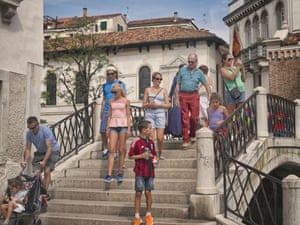1. Invest in some trekking poles.
If you haven’t used trekking poles before, have no fear. You’ll figure out how to use them right away. The Dolomites Alta Via 1 is a difficult trail with varying terrain and steep ascents and descents. Trekking poles will help you power up hill, keep your balance when you slip in mud, and reduce the strain on your knees and feet with every step you take. I had good luck with
Leki poles, but any poles will be better than none.
2. Pack light.
Scrutinize every item you bring and bring only the essentials. Remember, you’ll be carrying whatever you pack for around 90 miles and for 6 – 12 hours each day through the challenging Dolomites.
3. Bring sandals.
Most the rifugios require you to remove your boots before entering the main areas of the hut. Also, you’ll want them for showering to avoid getting athlete’s foot. Plus, they are great for taking your shoes off on longer breaks or when you find a nice cold stream to soak them in.
4. Quick drying clothes.
Since carrying a full wardrobe would make your pack unnecessarily heavy, bring clothes that are quick drying so you can wash them at the rifugios at the end of each day’s hike. Ex Officio make some great clothes that will be comfortable and designed for adventure travelers. Don’t forget your quick drying towel either.
5. Don’t skimp on socks.
Be sure to bring multiple pairs of hiking socks. I recommend swapping them out for a fresh pair at lunch – I promise that your feet will thank you. Hang your old ones off the back of your pack so they will air out and dry. It’s amazing the difference that a pair of new socks can make for your comfort.
NEED HELP PLANNING YOUR ITALIAN ADVENTURE CHECK OUT
ITALIAOUTDOOORS FOR TRIP PLANNING, TRAVEL GUIDES, AND TRIP REPORTS.
6. Get a pack that fits comfortably.
A quality hiking pack that properly fits can make or break the comfort of your trip. You’ll most likely be carrying around 25-35 lbs for 90 miles, so get a pack that fits you. Gregory and Osprey both make some quality packs that are priced well. Go to a store and check them out by filling them up with gear and walking around for a few minutes to see if they are comfortable.
7. Prevent chaffing and blisters.
This a topic that most don’t want to talk about, but let’s face it, after hiking 90 miles there will be some parts of you that rub a bit. Whether it’s blisters on your feet or chaffing in your thighs, some preventive maintenance with products like chaffing creams and body rubs can prevent a miserable experience before it starts. Body Glide andGold Bond both make anti-chafe products that apply like a deodorant and work great.
8. Trail runners vs. hiking boots.
Personally I recommend some comfortable hiking shoes or trail runners. Boots tend to be heavy, trap heat in, and after a long day in them you’re going to have some lazy feet (as I call it) and start stumbling on the trail. A pair of quality trail runners will be lightweight, comfortable, and give you great grip. I had great luck with my Vasque trail-running shoes but footwear really comes down to personal fit. Just make sure you choose something that fits well and give it a test hike prior to your trip. My last footwear tip is to ensure you trim your toenails prior to the hike. The steep downhills on Dolomites Alta Via 1 trails can put a pounding on your toes and even cause you to loose toenails over the course of the trip if they aren’t trimmed.
9. Get an early start.
Afternoon storms are the norm in the Dolomites and the northern areas in Italy, so start your hike early in the day. That leaves you a safety cushion should you get delayed during the hike and also leaves you more time to relax in the wonderful atmosphere at the Refugio's.
10. Enjoy the food.
Refugio's make some great food that will certainly satisfy your appetite on the trail. If you normally eat a big meal, consider the half-board option. It usually comes with a pasta as a starter then a hearty meat course like goulash stew or local sausage. Plus, it comes with a dessert. If you don’t want to pack lunches for the whole trip, just plan your route to stop at a rifugio for lunch as well. They make some great sandwiches take along in your pack to enjoy on a peak or vista..






















